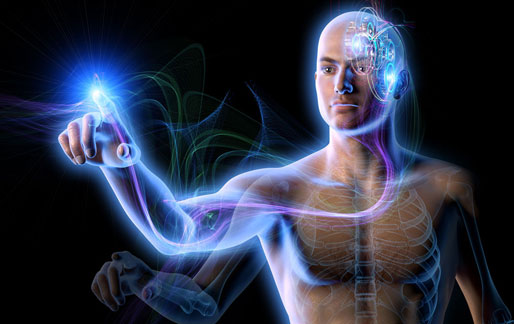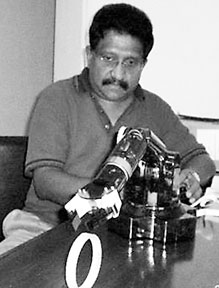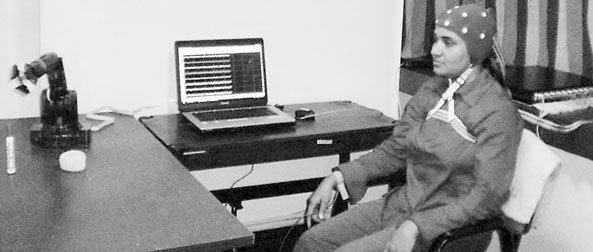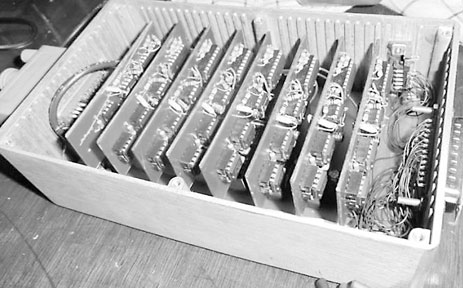Mind
over immobility
 A group of scientists from Kandy
are working on an affordable device to make the disabled live
independent lives A group of scientists from Kandy
are working on an affordable device to make the disabled live
independent lives
by Pradeep Priyathilaka
Thousands of people in the world are suffering from severe motor
impairments due to debilitating diseases, accidents and injuries. They
cannot walk, move their hands or speak with others; they just live in a
bed or a wheel chair. Can modern science provide relief to them?
For many years, several research laboratories around the world and
various research groups in Asia, Europe and USA have been working on
systems, which allow a direct dialogue between man and machine. These
systems are usually built based on two techniques, which depend on the
severity of the impairment.
One is a system, that enables the mind to control outside machines
with thoughts known as the 'Brain Computer Interface' or BCI, which is
literally a direct technological interface between a brain and a
computer that does not require any physical movement from the user. The
other method is communication through muscle movements (CMM), which uses
electric signals generating from muscles located in any part of the
body.
This means people with severe physical disabilities such as extreme
motor impairment (late stage Amyotrophic Lateral Sclerosis (ALS), severe
cerebral palsy, head trauma and spinal injuries can control equipment
such as wheelchairs and TVs, and are able to communicate with computer
voice in his or her native language (in Sinhala, Tamil or English) by
using their thoughts, muscle movements or eye movements. In these two
methods, neural impulses generated in the brain, eye or other muscles in
the body are intercepted and utilised to control electronic devices such
as a computer, TV, or a Radio.
|

Demonstrating BCI system |
A group of Sri Lankan scientist led by Professor Asiri Nanayakkara,
working at the National Institute of Fundamental studies, Kandy, has
developed a local BCI system based on Electroencephalogram (EEG), which
detects the brain activities due to changes in thoughts and a CMM system
using Electromyography (EMG), which detects the electrical potential
generated by muscle.
Low cost software
Imported BCI and CMM systems are quite expensive for most of the
people in Sri Lanka and they are needed to be custom - build according
to the medical condition of the patient. This means large number of Sri
Lankans cannot afford to own a BCI or CMM system equipment. One of the
aims of the investigations of Professor Nanayakkara and his research
team has been to design and develop a low cost software and hardware
needed for BCI and CMM systems. Another aim was to develop a real time
BCI system, which could be used by severely physically disabled people
in Sri Lanka.
Both BCI and CMM systems consist of two components; hardware and
software. With the hardware, EEG/ EMG signals generating from thoughts
of the brain or muscle movements of the body are amplified and then
digitised. The digitised EEG/ EMG signals are then analysed by a
computer, which then takes action according to the outcome of the
analysis -move wheel chair, on or off TV, lights and much more- using
pre-programmed instructions.
EMG signals are in millivolts, while EEG signal are very weak and
measured in microvolts. As a result, EMG signals are less likely to get
contaminated by noise generated by outside sources. Therefore, it is
always favourable to use CMM system wherever possible.
The degree of disability of the patient determines the method (BCI or
CMM), which is most suitable for him/her. If a patient can at least
control a single muscle, CMM is the best choice for communication.
 One
of the most popular mental tasks used for BCI systems is imaginary motor
movements (the patient is imagining that he/she is moving part of
his/her body). Not every thought of the brain can alter the EEG signal.
As a result, the number of thoughts which can make a detectable change
in EEG is very limited. One
of the most popular mental tasks used for BCI systems is imaginary motor
movements (the patient is imagining that he/she is moving part of
his/her body). Not every thought of the brain can alter the EEG signal.
As a result, the number of thoughts which can make a detectable change
in EEG is very limited.
Imaginary arrow movements
Professor Nanayakkara and his research group have been focusing on
finding new mental tasks, which can be used with their BCI system
effectively. And team has succeeded in finding a new set of mental
tasks, names imaginary arrow movements, which can be performed naturally
and identified by a BCI system accurately.
The performance of this new set of mental tasks has been tested and
found to be quite accurate and can be used to move the cursor on a
computer screen effectively.
As the first objective, the low cost 8 channel EEG/EOG (Electrooculogram)
amplifier, which had been constructed earlier in NIFS laboratory was
modified to be used with a real time BCI system. Amplification Unit
Filter Further a complete software package for recording EEG, EMG and
EOG (Electrooculography - a technique for measuring signals due to eye
movements) signals receiving from this amplifier was developed by his
research team. Further, an EEG based BCI software system (named GENIE)
was constructed to accept and classify signals from patients in real
time.
Since over 90% of the severely paralysed patients could make eye
movements, additional facilities have been incorporated into the BCI
system to accept commands through EOG due to slight eye movements. A new
hardware (remote control) system was developed in order to control
televisions, lighting and other equipment from the computer. This system
can be used to control televisions, adjust room lighting, and
communicate with Sinhala computer speech.
|

Amplification Unit |
The research team successfully demonstrated the BCI system using
Electroencephalogram (EEG), which detects the electrical potential
generated by thoughts, in front of a live audience at NIFS premises.
The research team is currently developing a portable, low
energy-consuming electronic BCI system, which uses a wireless link
between the brain and the computer. It is more comfortable than
conventional BCI systems due to the absence of wires, and provides the
ability for patient to move freely. They have scheduled to finish it by
the end of 2016.
The final aim of Professor Nanayakkara and his research team is to
successfully finish the portable BCI and CMM systems, which can be used
by patients with many types of physical disabilities to live actively
while interacting with outside world without being heavily dependent on
their love ones. There will be new hope to people with disabilities to
overcome some of the problems that they face in day to day life. BCI and
CMM systems which were successfully developed first time in Sri Lanka
can also be used in mobile phones, computer games and also in developing
new electric equipment in the near future.
(This article was compiled after discussing with the team leader of
the Artificial Intelligence and Applied Electronic research unit of
National Institute of Fundamental Studies, Professor. Asiri Nanayakkara.
. The writer is a Communication & Media Officer, Science Education &
Dissemination Unit, National Institute of Fundamental Studies, Kandy) |

